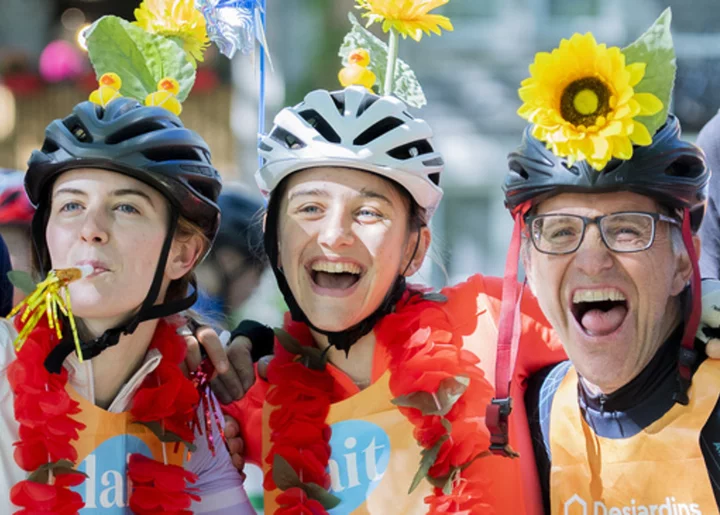MONTREAL (AP) — If the 21-story Leonard Cohen mural that commands Montreal’s skyline could talk, it might tell you what this city's crackling cultural life was like when the pandemic hit and everyone hunkered down. To borrow from his lyrics, it was a cold and a broken hallelujah.
The party's back on.
The first weekend in June, Montrealers will line sidewalks and porches, toot horns and shout “bonne journee” or just plain “go!" as swarms of cyclists wend their way through the iconic urban spaces of this bicycle-mad city.
The Go Bike Montreal Festival is traditionally and once more the kickoff to a spring and summer season of music, outdoor pursuits, art extravaganzas and other joie de vivre exuberance.
This is no race of hotshots. Rather, the crowds turn out to cheer on neighbors and strangers, some 20,000 of them in each of two main rides, during a week-long festival that celebrates Montreal’s status as one of North America’s best bicycling cities.
This, in a province with a vast cycling network — Route Verte — that National Geographic rated first among the world’s top 10 cycling destinations.
Velo Quebec, the cycling organization that manages the network and puts on the festival, considers this year's version to be the first full-blown one since COVID-19 at first crushed, then curtailed, the annual event and other large gatherings.
“We're back to historical numbers,” said Jean-François Rheault, Velo Quebec's CEO. “We're back in celebration mode. Now the celebration is almost everywhere in the city.”
The festival opens May 28 with the Metropolitan Challenge, covering routes as long as 145 kilometers (90 miles) in the nearby Monteregie countryside.
The classic events with closed-off downtown streets are the following weekend. On June 2, the hordes head out at sunset on Tour la Nuit, many in oddball costumes with bikes bedecked in carnivalesque lights. On June 4 comes the longer Tour de l’ile de Montreal, covering 45 km, or 28 miles.
Both urban rides begin and end at Parc Maisonneuve, site of Olympic Stadium, the Biodome and the Montreal Botanical Gardens. Other landmarks are en route or close by.
Rheault said the pandemic spurred cities including Montreal to accelerate improvements to bikeways. While bicycle commuting shrank in the city’s protracted and strictly enforced lockdown, plenty more people took up cycling as a way to avoid going stir crazy.
“Many who started biking realized they could safely and efficiently get around,” he said, and they’ve stuck with it.
In the 2019 Tour de l’Île a street corner in a forlorn warehouse district rang out with bracing songs in French from a Black choir as cyclists splashed through sheets of driving rain. Surprises like that are around one corner after another in the festival rides.
Quebec's dedication to bicycle commuting and touring development is well known in the cycling and urban-policy worlds, with the more than 5,000-km (3,000-mile) Route Verte as the backbone. Over a quarter century, bikeways — bicycle paths, multipurpose trails, protected bike lanes and safe shoulders — have grown five-fold.
Velo Quebec counts 10,600 km or nearly 6,600 miles of bikeways in the province. For Montreal alone, its studies find that 2 in 3 adults used a bike for utility purposes — work commutes, shopping, errands — in 2020, up from 42% five years earlier.
The Colorado-based advocacy and research group PeopleforBikes, which produces worldwide ratings on urban biking, ranks Montreal No. 1 among large cities in North America for bike-friendly attributes.
Similarly, an MIT book on global cycling trends by urban planning researchers John Pucher of Rutgers University and Ralph Buehler of Virginia Tech named Montreal a world leader in establishing a safe network for bike commuting and recreation.
Pucher told the AP the city was “way ahead of the curve” in producing “the most comfortable, the least stressful bicycling infrastructure.”
Even before COVID got even more people on bikes, Montreal experienced a nearly two-thirds drop in the rate of serious cycling injuries since 2000 as the city's bike network more than doubled, Buehler and Pucher found.
Cycling in the U.S. and Canada has been shaped by three waves, said Rheault, of Velo Quebec.
First came initial bike trails in the 1970s, many in existing parks. Then a surge in bike paths and the advent of urban bike-share from 2005 to 2010. The COVID era brought on the third wave as e-bike sales have surged and the next generation of bike lanes, wider and better protected than before, has taken shape.

